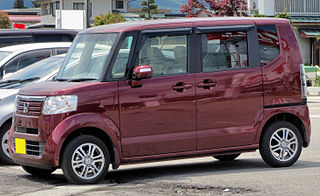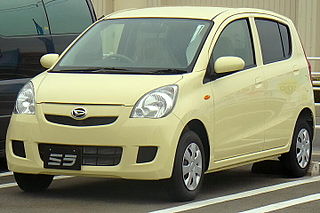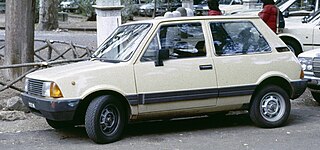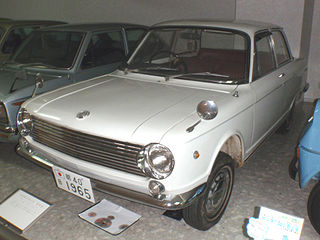Related Research Articles

Daihatsu Motor Co., Ltd., commonly known as Daihatsu, is a Japanese automobile manufacturer and one of the oldest surviving Japanese internal combustion engine manufacturers. The company's headquarters are located in Ikeda, Osaka Prefecture.

Kei car, refers to the Japanese vehicle category for the smallest highway-legal passenger cars, with restricted dimensions and engine capacity. Similar Japanese categories exist for microvans and kei trucks. These vehicles are most often the Japanese equivalent of the European Union's A-segment "city cars".

The Subaru Rex, also known as Ace, Viki, Sherpa, 500/600/700, Mini Jumbo, Mini Subaru or M60/M70/M80 in various export markets, is a kei class automobile produced from 1972 to 1992 mainly for sale in Japan by Subaru, although it was also sold in Europe, South America, Australia and the Caribbean. The Rex superseded the R-2 as Subaru's kei car, and has been available in commercial use versions as well as in a passenger car version. It underwent major changes in 1976, in fall 1981, and again in late 1986. The second generation Rex (1981–1986) also formed the basis for the larger Subaru Justy.

The Daihatsu Mira is a kei car and city car built by Japanese car maker Daihatsu. It has a variety of options and chassis variations, with the latest variant having four models: Mira, Mira AVY, Mira Gino, and Mira VAN. The Mira is the latest successor to the line of cars begun with the Daihatsu Fellow of 1966, and was originally introduced as the commercial version of the Cuore. Outside of Japan, the Mira has also been offered with larger 850 or 1000-cc engines. In Australia, the two-seater version was marketed as the Daihatsu Handivan and later as the Daihatsu Handi. The term mira is Latin meaning "goal" or "purpose".

The Daihatsu Fellow Max is a small Japanese automobile in the Kei car class. Originally introduced as the Daihatsu Fellow, the name was partially retained for its successor, the Max Cuore (1977), and then revived in 2000 for the Daihatsu Max.

The Innocenti Mini is an automobile introduced by Innocenti in 1974. The vehicle was a rebodied, three-door hatchback version of the Mini, styled by Bertone. A five-door prototype was developed around 1980, but was never put into production. After having been sold to De Tomaso in 1976, the Innocenti Mini ended up being powered by Daihatsu-sourced three-cylinder engines and continued in production in incrementally updated forms until 1993.

The Suzuki Fronte is an automobile that was first introduced in March 1962 as a sedan version of the Suzulight Van. The nameplate remained in use for Suzuki's Kei car sedans as well as some commercial-use derivatives until it was replaced by the Alto name in September 1988. The word "fronte" alludes to the fact that the car is front-wheel-drive, although during the years when the Fronte was rear-engined, rear-wheel-drive, Suzuki stated that it referred to the car being at the front of the Kei class.

The Daihatsu Hijet is a cab over microvan and kei truck produced and sold by the Japanese automaker Daihatsu since 1960. Despite the similarities between the Hijet name and Toyota's naming scheme for its trucks and vans, the name "Hijet" has been in use for Daihatsu's kei trucks and microvans since 1960, over two decades before Toyota took control. "Hijet", when transliterated into Japanese, is very similar to "Midget", one of Daihatsu's other mini-trucks. According to Daihatsu, the name "Hijet" was created to imply that the vehicle offers higher performance than the Midget. The Hijet competes in Japan with the Honda Acty, Mitsubishi Minicab, Nissan Clipper, Subaru Sambar and Suzuki Carry.

The Subaru Sambar is a cabover truck and microvan manufactured and marketed by Subaru as Japan's first truck compliant with the country's strict Keitora (軽トラ) or Kei vehicle tax class. Introduced in 1961 in microvan and Kei pickup configurations, the Sambar remains in production, now in its eighth generation — beginning with the sixth generation as a rebadged Daihatsu Hijet.
The Suzuki Cervo is a kei car manufactured by Suzuki Motor Corporation. Introduced in 1976 as the successor to the Suzuki Fronte Coupé, the Cervo name was originally affixed to a kei sports coupe, and then to models derived from the Suzuki Alto. The nameplate was retired between 1998 and 2006, and again in December 2009.

The Daihatsu Gran Max is a series of light commercial vehicles produced and sold by the Japanese automaker Daihatsu since late 2007. It is also rebadged and marketed by Toyota as the Toyota LiteAce and Toyota TownAce since 2008, and by Mazda in Japan as the Mazda Bongo since 2020.

The Suzuki Fronte 800 is a subcompact car with a two-stroke engine built by the Suzuki Motor Corporation in the latter half of the 1960s.

LC10 was the original name given to a series of very small three-cylinder, two-stroke engines built by Suzuki Motor Corporation in the 1960s and 1970s. They were used in a number of kei class automobiles and light trucks. The LC10 and its derivatives did not completely replace the FE and L50 two-cylinders, which continued to be used mainly for light commercials. The LC10 engine was developed together with the Suzuki B100 engine, a 8–11 PS (5.9–8.1 kW) 118.9 cc (7.26 cu in) single-cylinder motorcycle engine which shared the same bore and stroke. For longevity and convenience, the LC10 received Suzuki's new "Posi-Force" auto-lubrication system, eliminating the need for pre-mixed fuel.

The Daihatsu E-series engine is a range of compact three-cylinder, internal combustion piston engines, designed by Daihatsu, which is a subsidiary of Toyota. The petrol-driven series has cast iron engine blocks and aluminum cylinder heads, and are of either SOHC or DOHC design, with belt driven heads.

Toyota TTC stands for Toyota Total Clean System, a moniker used in Japan to identify vehicles built with emission control technology. The technology was installed so that their vehicles would be in compliance with Japanese Government emission regulations passed in 1968. The term was first introduced in Japan, with an externally mounted badge on the trunk of vehicles equipped. The technology first appeared in January 1975 on the Toyota Crown, the Toyota Corona Mark II, the Toyota Corona, the Toyota Carina, the Toyota Corolla, and the Toyota Sprinter. There were three different versions initially introduced, called TTC-C for Catalyst, installing a catalytic converter, TTC-V for Vortex, installing an exhaust gas recirculation valve, and TTC-L which used a lean burn method. As Toyota's technology evolved the three systems were eventually used in conjunction in future models.
The Daihatsu C-series engine is a range of compact three-cylinder, internal combustion piston engines, designed by Daihatsu, which is a subsidiary of Toyota. The engines range from 843 to 993 cc and have been manufactured in petrol and diesel-driven series. They have cast iron engine blocks and aluminum cylinder heads, and are of either SOHC or DOHC design, with belt driven heads. The engine first appeared in the all-new Daihatsu Charade in October 1977, in "CB20" form.

The Suzuki FB engine is a series of two- and three-cylinder two-stroke engines that was produced by the Suzuki Motor Corporation from October 1961 until November 1987. They were used in a number of Kei-class automobiles and light trucks. From the original air-cooled 359 cc (21.9 cu in) straight-twin version the FB series developed through a number of different models having different names, ending with the water-cooled, three-cylinder LJ50. The names used for various versions of this engine often refer to the chassis code of the cars in which they were introduced, until Suzuki changed their engine naming system sometime in the first half of the 1970s.

The Suzuki F engine is a series of inline three- and four-cylinder internal combustion petrol engines manufactured by Suzuki Motor Corporation and also licensed by many manufacturers for their automobiles. This engine was Suzuki's first four-stroke car engine when it first appeared in 1977.
References
- ↑ Yamaguchi, Jack K. (1977), "The Year of the Third Power", World Cars 1977, Pelham, NY: The Automobile Club of Italy/Herald Books: 56–57, ISBN 0-910714-09-6
- ↑ Ferrari, Alessandro (September 1984). "Due cilindri che sembrano quattro" [Two cylinders which feel like four]. Quattroruote (in Italian). Milan, Italy: Editoriale Domus. 29 (347): 71.
- ↑ Baobab Street, Enjoy, p. 130
- 1 2 Baobab Street, Enjoy, p. 133
- ↑ Büschi, Hans-Ulrich, ed. (1987-03-05). Automobil Revue 1987 (in German and French). Vol. 82. Berne, Switzerland: Hallwag AG. p. 240. ISBN 3-444-00458-3.
- ↑ World Cars 1977. Pelham, NY: The Automobile Club of Italy/Herald Books. 1977. p. 342. ISBN 0-910714-09-6.
- ↑ "O Sado 550" [The Sado 550]. Sado/550: Site não oficial do SADO 550 (in Portuguese).
- ↑ Ozeki, Kazuo (2007). Suzuki Story: Small Cars, Big Ambitions (in Japanese). Tokyo: Miki Press. pp. 66–67. ISBN 978-4-89522-503-8.
- ↑ 自動車ガイドブック[Japanese Motor Vehicles Guide Book] (in Japanese), vol. 25, Japan: Japan Automobile Manufacturers Association, 1978-10-10, p. 291, 0053-780025-3400
- ↑ Costa, André & Georges-Michel Fraichard, ed. (September 1979), Salon 1979: Toutes les Voitures du Monde (in French), Paris: l'Auto Journal, p. 175
- ↑ Daihatsu 550 Sedan: Max Cuore (brochure), Osaka, Japan: Daihatsu Motors, 1978, p. 12, 1103/150/53005
- 1 2 Mastrostefano, Raffaele, ed. (1985). Quattroruote: Tutte le Auto del Mondo 1985 (in Italian). Milano: Editoriale Domus S.p.A. p. 234. ISBN 88-7212-012-8.
- 1 2 初代アトレー [First generation Atrai] (in Japanese). アトレークラブ2 [Atrai Club 2]. Retrieved 2012-12-27.
- Works cited
Baobab Street (バオバブストリート) (1987). エンジョイ・ダイハツ ミラ, クオーレ/リーザ[Enjoy Daihatsu Mira, Cuore/Leeza]. マイカーエンジョイマニュアル [My Car Enjoy Manual] (in Japanese). Tokyo: Sankaido (山海堂). ISBN 978-4-381-07561-1.